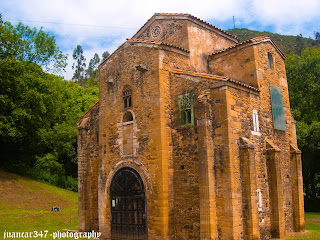Comparaciones / Comparisons
Soy consciente de que las comparaciones, como asevera un
viejo refrán popular, pueden resultar odiosas, pero también mantengo la
opinión, de que, en ocasiones, se convierten en un providencial aliado, que
aumenta nuestra perspectiva a la hora de hablar de ciertos lugares, que, por
alguna curiosa circunstancia, afín, sin duda, a las leyes de la asociación, nos
familiarizan con parte de la historia de otro lugar. En este caso, con la
figura del mago Merlín, que no era tan encantador como nos lo pintó Walt
Disney, pero sí probablemente un sabio sacerdote druida que vivió y jugó un
papel extraordinario en la época en la que un oscuro caudillo celta, Arturo,
comenzó a destacar en Britania, más o menos coincidiendo con el momento en el
que el Imperio Romano de Occidente comenzaba a colapsar y los bárbaros de
Alarico amenazaban Roma, la que finalmente tomaron al asalto.
Tal y como se refiere, en la historia de Uther Pendragon, el padre de Arturo, la primera aparición de Merlín se produjo cuando aquél, desesperado de ejecutar a arquitectos inútiles, le encomendó, bajo pena de muerte, también, la acometida de los trabajos para que el castillo en construcción no volviera a derrumbarse. La solución, sencilla, no consistía en otra cosa que en correr los cimientos algunas decenas de metros, alejándolos del manantial de agua subterránea en el que, incomprensiblemente, se habían dispuesto. Historia y detalle, que también afecta a este soberbio exponente del Arte Prerrománico asturiano, afeando el inconmensurable trabajo de un arquitecto anónimo que trabajó para las primeras dinastías reales que sucedieron en el trono a Don Pelayo, buena parte de cuya estructura está hundida en el suelo, afectada por las corrientes subterráneas de agua que se localizan en buena parte del prado en el que se asienta.
I am aware
that comparisons, as an old popular saying asserts, can be odious, but I also
maintain the opinion that, sometimes, they become a providential ally, which
increases our perspective when talking about certain places, which, by some
curious circumstance, related, no doubt, to the laws of association,
familiarize us with part of the history of another place. In this case, with
the figure of the wizard Merlin, who was not as charming as Walt Disney painted
him, but was probably a wise druid priest who lived and played an extraordinary
role in the era in which a dark Celtic leader, Arthur, began to stand out in
Britain, more or less coinciding with the moment in which the Western Roman
Empire began to collapse and Alaric's barbarians threatened Rome, which they
finally took by storm.
As
mentioned, in the story of Uther Pendragon, Arthur's father, Merlin's first
appearance occurred when he, desperate to execute useless architects, entrusted
him, under penalty of death, to undertake the work. so that the castle under
construction would not collapse again. The simple solution consisted of nothing
more than moving the foundations a few dozen meters, moving them away from the
underground water spring in which, incomprehensibly, they had been placed.
History and detail, which also affects this superb exponent of Asturian
Pre-Romanesque Art, disfiguring the immeasurable work of an anonymous architect
who worked for the first royal dynasties that succeeded Don Pelayo on the
throne, a good part of whose structure is sunken into the ground, affected by
the underground water currents that are located in a good part of the meadow in
which it sits.
AVISO: Tanto el texto, como las fotografías que lo
acompañan, son de mi exclusiva propiedad intelectual y por lo tanto, están
sujetos a mis Derechos de Autor.
NOTICE:
Both the text and the accompanying photographs are my exclusive intellectual
property and are therefore subject to my Copyright.









Comentarios